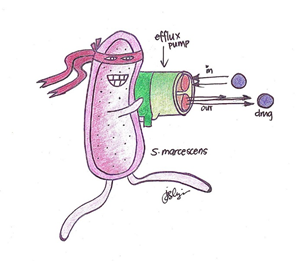Heterogeneous partition of multidrug efflux pump and emergence of antibiotic resistance
Emergence of antibiotic resistance bacteria is one major problem of the modern era. Bacteria are developing resistance against antibiotics at alarming rate and we are running out of effective antibiotics. Bacteria deploy several short- and long-term adaptive strategies to counteract the effect of potent antibiotics. Short-term strategies include pumping out drugs using multi drug efflux pumps and ceasing growth. Short-term adaptation provides valuable time to prepare for the long-term adaptation, where bacteria make permanent adaptive changes in the genome to acquire permanent resistance against the antibiotic in question. Studies have demonstrated that partitioning of multidrug pump AcrAB-TolC during the bacterial cell division is heterogenous and daughter cells with higher fraction of multidrug pump elicit enhanced level of drug tolerance. A recent study by the Meouche et al (2018) demonstrated that bacterial species such as Escherichia coli and Salmonella typhimurium overexpressing acrAB, grown in different antibiotics, demonstrate elevated level of mutation rates compared to wild type cells [1]. Mutation rates were 1.06 × 10−8 and 2.84 × 10−8 mutations per generation in the wild-type and acrAB strains, respectively. This study also reports that a higher number of multidrug efflux pumps causes reduction in the growth rate and represses the expression of mutS. MutS is involved in DNA mismatch repair system which is a crucial step in preventing mutations, while mutS knockout bacteria demonstrate hypermutable phenotype. A modest increase in mutation rate can have significant impact on enrichment of resistant bacteria in selective condition. Though, now we understand the contribution of unequal partitioning of multidrug efflux pump on the emergence antibiotic resistance phenotype, several molecular mechanisms are yet to be figured out such as the mechanism of repression of mutS by acrAB. Detailed understanding of the molecular mechanism of emergence of antibiotic resistance will help drug developer to design the long lasting antimicrobial agents.
References:
[1] El Meouche, I., & Dunlop, M. J. (2018). Heterogeneity in efflux pump expression predisposes antibiotic-resistant cells to mutation. Science, 362(6415), 686-690.
Picture credit:
https://microbewiki.kenyon.edu/index.php/Serratia_marcescens%27_different_drug_resistant_efflux_pumps
